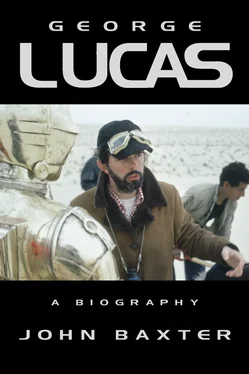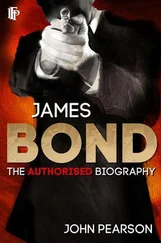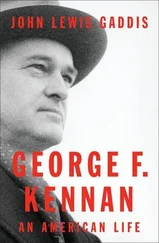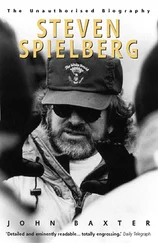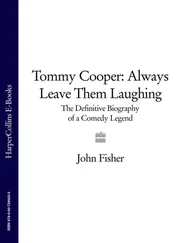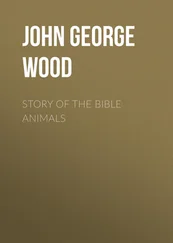The sound equipment arrived, and was installed while carpenters were still sawing in the corridors. Walter Murch arrived on his BMW motorbike to supervise. For him, the chance to work on a state-of-the-art Keller system was more than enough reason to relocate to the Bay area. Able to handle seven separate strips of film in gauges from 8mm to 70mm, and video as well, it was the most advanced piece of equipment of its type in America – so advanced that when it broke down, an engineer had to fly in from Hamburg to fix it.
Word quickly spread of the radical new venture. Stanley Kubrick, cinema’s most famous recluse, corresponded with Coppola about special effects from his rural hideout in England. John Schlesinger said he wanted to rent space. Mike Nichols intended to invest. One night, Coppola was making coffee in the conference room when Orson Welles rang. He was thinking of making a film in San Francisco, he said. Awed, Coppola talked with him for half an hour, coffee pot in his hand, while the water overflowed from the sink and flooded the room.
American Zoetrope officially became an entity on 14 November 1969, when Coppola’s attorney filed the incorporation papers. The facility, though still far from ready, was opened by San Francisco’s Mayor Joseph Alioto on 13 December. Alioto announced that Coppola had already spent $500,000 on equipment, never mind staff. Except for John Korty, who was cutting his feature Riverrun , the only person actually working there was Haskell Wexler, who was shooting a huge rock concert being held at nearby Altamont with the Maysles brothers. He offered Lucas a few days’ work as a cameraman, and Lucas was there on the day when Hell’s Angels employed as security men murdered a member of the audience, Meredith Hunter. John Milius insists that Lucas shot the scenes of the killing which were later used in the documentary Gimme Shelter . Lucas says he can’t remember.
American Zoetrope became a target of pilgrimage. ‘It all looked too good to believe,’ said one early visitor, ‘terribly chic and terribly sincere, with leggy secretaries in crocheted miniskirts, $50,000 KEM and Steenbeck editing tables, Creative Playthings paraphernalia, bubbly chairs, and blowups of D.W. Griffith on the walls.’ The main reception area was dominated by a pool table and a silver espresso machine. Fabrics from the Finnish company Marimekko draped the walls, their purples, oranges and yellows echoed even in the décor of the freight elevator. Every Thursday night, Coppola screened classic movies, with a buffet of Chinese food. A lavish brochure in faux art-nouveau style promised films and facilities that combined the best of Europe and America, of Hollywood and the Bay area.
Prospective tenants soon found it was too good to believe. Zoetrope could only handle the kind of films Coppola wanted to make: mobile movies shot on location with hand-held cameras. There was no sound stage, and only minimal facilities for wardrobe and props. Coppola had recklessly paid $40,000 for a Mitchell BNCR camera which nobody could afford to rent, and bought a range of the latest lightweight Arri-flexes and portable tape recorders. His old mentor Roger Corman came to take a look. As well as being godfather to Coppola’s son Gio, he was an executor of his will. Coppola asked him what would happen to all this equipment if he died. Corman said, ‘I’ll put it all in a truck and take it down to LA, because you’re in the wrong city, Francis.’
Instead of presiding over a cinematic renaissance, Coppola found himself trying, without success, to supervise a tribe of vigorous young film-makers, all looking out for themselves. ‘Everyone was off in his own little corner, competing,’ recalls Carroll Ballard. $40,000 worth of equipment disappeared in the first year, and a number of company cars were cracked up. Desperate to put the facility in profit from the start, Coppola set rental rates that were high for the time: $175 a month for one of the seven cutting rooms, $240 a month for an editing machine to go in it, and correspondingly more for office services, production facilities and time on the Keller console. He was parsimonious when it came to funding the projects which would be Zoetrope’s lifeblood. To write and direct THX , Lucas would get only $15,000; but even that was not immediately forthcoming.
Lucas, fretting about being able to replicate the clinical emptiness of his student THX , wondered if he could shoot in Japan. ‘The idea was, it was this weird dictatorial society in the future,’ says Gary Kurtz, ‘and if it was totally alien as an environment to the audience, and it was in a foreign language, you might be able to believe in the isolation of the main characters. Well, nobody in Hollywood liked that idea.’ All the same, Coppola truculently announced Japanese locations as an accomplished fact. ‘George is going to direct it in his own way. I’m giving him my strength. I’m saying, “If you want me, you’ve got to give George Lucas his break.”’
Warners weren’t sure they wanted either of them, particularly when they got around to reading the script of THX1138 . It had little real plot, aside from the idea of a man fleeing an overpowering society. There was no motivation. Nobody was characterized. The ending was ambiguous, THX climbing from a manhole into a world of which we see nothing except a huge sun and a solitary bird.
Lucas sulked. ‘Of course,’ he said, ‘at the studio they don’t understand scripts; that they should look more like blueprints than novels. They don’t even know who [Marshall] McLuhan is over there.’ Nevertheless, he asked Walter Murch to help with the script, and they amplified the story where they could. ‘We just threw everything up in the air and watched it come down,’ said Murch. The setting was narrowed down to the twenty-fifth century. They sketched in some social background. Everyone is tranquillized, and their sex drive numbed by drugs. They wear only white, and their heads are shaved. Most, including THX – pronounced ‘Thex’ – who works on a production line assembling robots, have been grown parthogenetically, by artificial insemination, but his girlfriend LUH7117 – ‘Ler’ – is a ‘natural born,’ and therefore suspect.
A god, OMM, dark-eyed, Semitic, with a sensual mouth and a short black beard – the physical antithesis of his predominantly Caucasian subjects – watches unblinking from every wall. He offers benign moral supervision, urging: ‘Work hard, increase production, prevent accidents, and be happy.’ Citizens commune with him in electronic booths that also fulfil the function of psychoanalysts. A taped voice – Murch’s – welcomes them with ‘My time is yours,’ and responds to their pleas for help with anodyne recorded comments, and an absolution that ends in the exhortation to get back to work. Anyone who demands more is likely to be arrested and beaten by police, sometimes to death, on television.
Robots, uniformly tall, dressed in the black leathers and white helmets of Californian Highway Patrol motorcycle cops but with blank chrome faces – another gibe by Lucas at the bêtes noires of his adolescence – impose law and order. During the film we see one of these robots, malfunctioning, walk repeatedly into a wall. Another, ominously, is seen shepherding a tiny child into an elevator.
In the feature version, LUH seduces THX by reducing the medication that suppresses his sexual instinct. Previously satisfied with telecasts of ritual beatings and callisthenic-like dancing by a bald, naked black woman, THX is persuaded to make love to LUH. ‘It manages to have a lot of nudity in it,’ says Richard Walter of the film, ‘but to be anti-erotic. George’s work is extremely non-sexual. He is uncomfortable with sexuality’ – a view borne out by close-ups of LUH and THX’s pale, hairless bodies pressed together in joyless union.
Читать дальше
